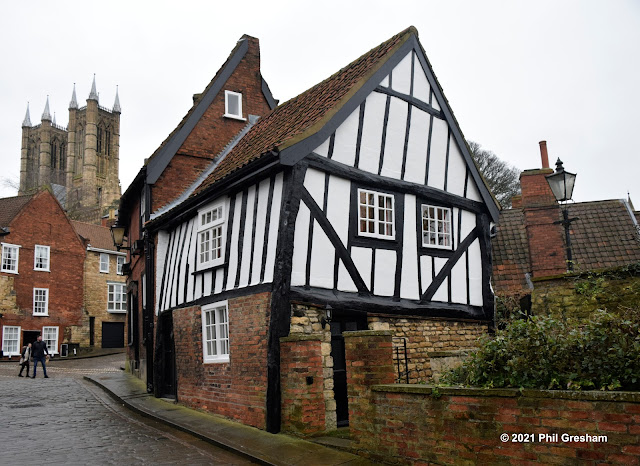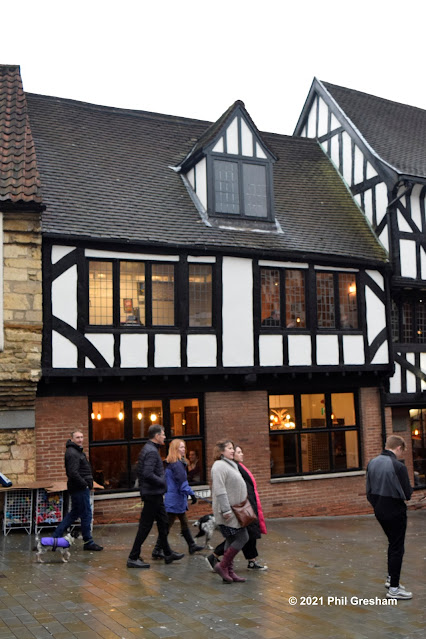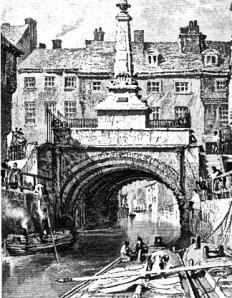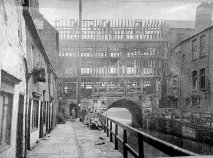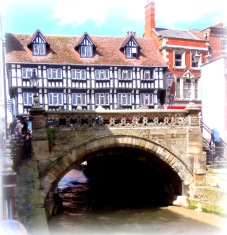Lincoln is fortunate in its number of half-timbered buildings, many of which have survived for 500 years or more. Built at a time of prosperity most were later painted in dull colours when Lincoln no longer had the wealth it once had, and not the stunning black and white we see today.
Anyone who knows Steep Hill will understand why I am starting at the top!
Visitors will find the Tourist Information centre very usefully set on Castle Hill between the Cathedral and the Castle at:
Leigh-Pemberton House
Leigh-Pemberton House was a merchants house when it was built in 1543. Extensive restoration was carried out by the National Provincial Bank in 1929 & 1970 and presented to the Dean & Chapter of Lincoln Cathedral on 31st May 1979; the building was named after the then chairman of National Westminster Bank, Robin Leigh-Pemberton. The ground floor is used as a Tourist Information office and the upper floors are self-catering accommodation.
The building stands over Via Principalis, the Roman road that runs north to Newport Arch and via Steep Hill.
38-39 Steep Hill
38 & 39 Steep Hill dates from the 16th century, with late 18th and 19th-century modifications.
The Harlequin
The Harlequin Inn (once known as the Harlequin and Columbine, when it was connected with the theatre on Drury Lane) dates from the 15th century, first recorded as an inn in the mid 18th century. In 1931 it was refused the renewal of its alcohol licence as "structurally unsuitable". George Shelton was an antique furniture dealer for about 30 years and then it was the Harlequin Galleries, an antiquarian bookshop, for almost 50 years until it closed a few years ago.
The Crooked House at the top of Michaelgate is well known, and is probably one of the most photographed buildings in Lincoln after the Cathedral, Castle and Stonebow.
This house looked like any other terraced house until the 1930s. At that time there was a major slum clearance throughout the city; in areas close to the factories and foundries of the Waterside, even Jews Court was in danger of being lost until it was rescued by the Lincolnshire Architectural and Archaeological Society (now The Society for Lincolnshire History and Archaeology). In late 1933, a demolition order was issued for numbers 34, 36, 38 and 40 Michaelgate. When demolition of number 40 began it was discovered there was a half-timbered building behind the brick façade. The owner of the house asked the council to rescind the demolition order. Permission was granted by the Minister of Health subject to it not being used for human habitation.
The house was acquired by Lincoln Council and renovated to its original style; it became one of the oldest council houses in England. The house is still owned by the City of Lincoln Council and managed by the National Trust.
Click here to read about the interior of the house
Dernstall House dates from the late 15th century, altered in the 17th and 18th centuries and restored in 1969.
The Cardinal's Hat building is thought to be named after Cardinal Wolsey and dates from the 15th or 16th century. Originally the home of the Grantham family, after which the nearby street was named later becoming an inn, it remained so until the early 19th century, when it was known as the Cardinal's Cap. In 1872 it was the premises of Albert W Hall, grocer & baker, established in 1790. Over the years it became a furniture store until the St John's Ambulance made it their county headquarters and the building was renovated in 1952.
After almost 200 years it is now a public house again.
High Bridge
The Green Dragon
The Green Dragon is a four-gable half-timbered building dating from the 16th century. It was probably built for a wealthy Lincoln merchant, and bought by the Common Council of the City of Lincoln from Thomas Grantham in 1569. By 1624 it was known as the Great Garrettes, it remained as tenements and shops until the 1950s.
There was a major restoration of the building in the late 1950s, and the Green Dragon public house moved here from an adjoining brick-built building on the east side of the present building.
The Treaty of Commerce
The Treaty of Commerce is one of the most central pubs in Lincoln; many other central pubs have closed since the 1970s. The name is said to have come from an 1860 trade treaty with France. It was named Treaty of Commerce in 1867. Owned by Ind Coope from 1911. The plaster and timber frontage was added in 1926 for Ind Coope.
Became O'Donoghues Irish Bar in the 1990s, renamed Honest Lawyer from October 2000 to November 2001. Reverted to The Treaty of Commerce in November 2001, when it was acquired by Bateman's Brewery
Whitefriars House
 |
| By Alfred Ernest White c1880 - Art UK, Public Domain, https://commons.wikimedia.org/w/index.php?curid=45247605 |
Sadly only one wall now exists of Whitefriars House, but it has been protected from the elements by the building on the opposite side of Akrill's Passage.
It was called Whitefriars because it was once thought to be part of the Whitefriars Priory; but during the re-development of the Midland Station the remains of the priory was discovered.
By Richard Croft, CC BY-SA 2.0,
https://commons.wikimedia.org/w/index.php?curid=13622278
The original building dates from the 15th century and it has suggested that it could be the former vicarage of St Mary le Wigford. It was restored in the late 20th century and a shop front added.
It is difficult to get a good photograph of the building so I have used a photograph from when the neighbouring building was rebuilt.




